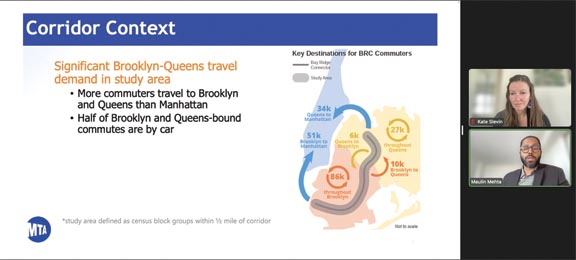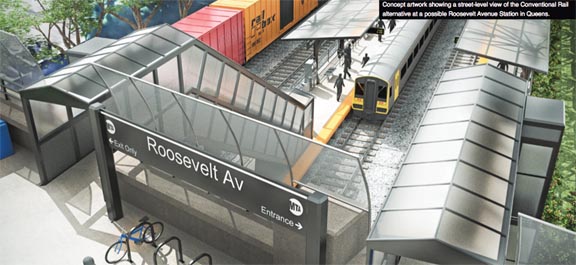RPA Gives Chamber Insider View of IBE
ABOVE: Concept artwork showing a street-level view of the Conventional Rail alternative at a possible
Roosevelt Avenue station in Queens. (Rendering courtesy of MTA)
BY JESSICA MEDITZ
As Regional Plan Association (RPA) celebrates its centennial year, a variation of one of their proposals to connect Queens and Brooklyn via rail is finally gaining some traction thanks to the recent support of Governor Kathy Hochul.
The Queens Chamber of Commerce recently hosted a webinar with Maulin Mehta and Kate Slevin of RPA, who shared an insider’s view of the Interborough Express, which would use existing freight rail lines to connect neighborhoods from Jackson Heights to Bay Ridge.
Since 1929, RPA has released four regional plans, which have contributed to some of the region’s most notable infrastructural solutions. Their 2017 regional plan largely focuses on improving transportation, especially for commuters in the outer boroughs.
“The subway system was designed primarily to get people in and out of Manhattan, and it’s been a challenge,” said Slevin. “So we really try to push for investments that benefit the regional centers, because we know Manhattan can’t do it all itself.”
She cited potential job growth, quicker commute times and more accessibility among the reasons why the Interborough Express would benefit Brooklyn and Queens residents.
“We saw these centers as hubs for job growth and economic growth, and transit projects are a cornerstone to allow this vision to play out,” said Slevin. “So many more people in New York are actually close to a bus system, but they don’t use it because the buses are so slow.”
She said that ambitious plans to get more protected bus lanes will not solve everything, and that stronger inter-borough transit connections are necessary. The proposed 24-mile Interborough Express would use existing tracks to connect 17 subway lines, four commuter rail lines and dozens of bus lines. It would extend from Jackson Heights to Bay Ridge in Brooklyn and could serve as many as 100,000 riders per day.
The original RPA proposal called for extending the line all the way to the Bronx, but the plan put forth by the governor would terminate in Jackson Heights. Mehta said the group was excited when the MTA announced they would fund a feasibility study, getting the proposal one step closer to reality.
“With increased job growth and population growth in the outer boroughs, there was really a need to rethink how our transit system operates,” said Mehta. “And now here we are, the governor, MTA, and so many other leaders are aligned in a vision to move a part of the division forward.”
Mehta emphasized that the line would largely service low-income and communities of color. He noted that such an advancement would allow for the city to grow and entice more people to live and work in the neighborhoods served by the line. Because of that growth, part of RPA’s plan looked at ways to expand and mingle freight service with passenger service, since freight traffic is so limited.
“We’ve seen during the pandemic a tremendous need to get goods moving efficiently,” said Mehta. “Increasing freight service would continue to get trucks off the road and meet some of our climate change goals.
“The good news is that around the world, this has been done,” he added. “So there is a possibility to continue to grow freight and passenger service so that everyone is served.”
RPA speculates that the environmental review the MTA needs to undertake could be completed soon and some of the project could be funded as part of the agency’s 2025-2029 capital program.
“If funding gets lined up, the study goes well and it gets included in the capital plan, there is a chance that we could see this by the end of the decade,” said Mehta.





